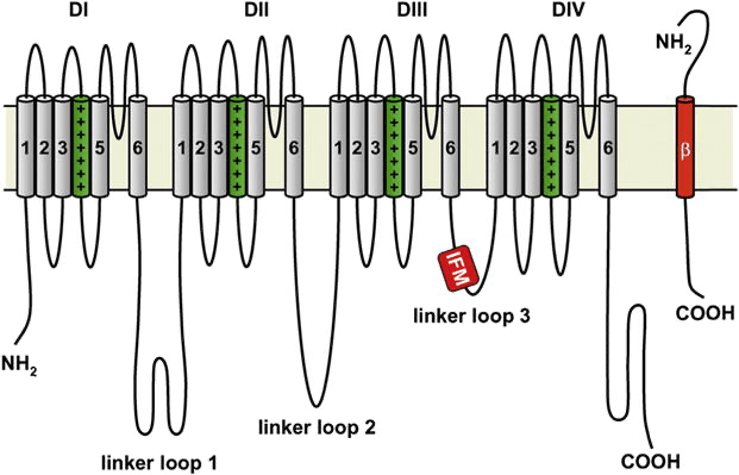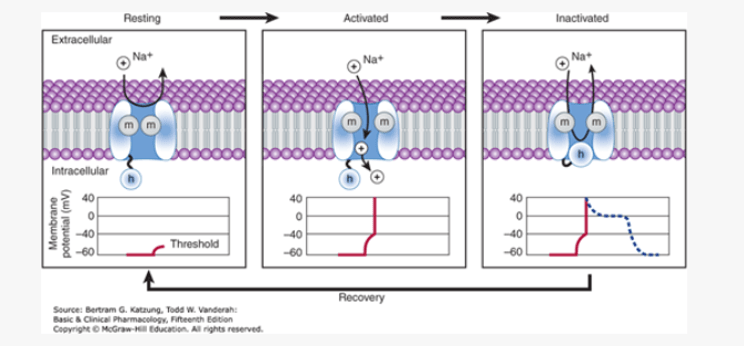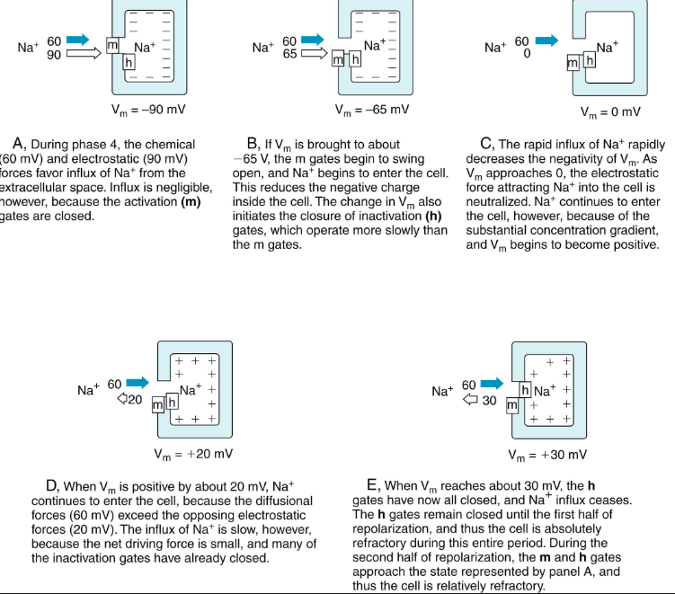22B05: Exam Report
Outline the structure of fast cardiac sodium channels and describe in detail how they work
18% of candidates passed this question.
The expectation for this question was an appropriate description of the fast sodium channel structure included outlining its single alpha and 2 beta sub-units, activation (m) and inactivation (h) gates and sodium selectivity.
It was expected that candidates would comment on cycling between the 3 states (resting, open and inactive), corresponding conformational changes to the fast sodium channel, triggers for these changes (voltage or time) and ionic events, including reference to and description of absolute and relative refractory periods.
Better candidates were able to relate events to a diagram of a fast action potential, simply drawing a diagram without referencing events at the sodium channel scored few marks. No marks were awarded for description of drug effects on the fast sodium channel.
The question specifically relates to fast Na channels, so descriptions of other channels (e.g. ligand gated sodium channels) did not score marks. Details of the subsequent contraction of cardiac muscle following an action potential was also not part of the question and did not score marks.
G2i / Eiii / 22B05: Outline the structure of fast cardiac sodium channels and describe in detail how they work
Structure
The human cardiac sodium channel hNa(v)1.5 is a member of the family of voltage-gated sodium channels.
The channel consists of:
- Single primary alpha sub-unit (composed of 4 domains, I to IV with each consisting of 6 transmembrane alpha-helical segments linked by external and internal peptide loops.)
+ Transmembrane segment 4 serves as a sensor whose conformation changes with applied voltage and is responsible for channel opening (activation)
++ The intracellular loop that connects domains III and IV functions as the inactivation gate (h)
+++ Extracellular portions of the loops connecting helices 5 and 6 in each domain form the pore region and participate in the determination of ion selectivity.
- Two secondary b-subunits – modulate gating, regulate expression
- Activation (m) and inactivation (h) gates
4 domains of the alpha-subunit are arranged around a central pore lined by the extracellular loops of transmembrane segments 5 and 6.

Cycle and relevant conformation changes

Depolarisation of the membrane by an impulse propagating from adjacent cells results in opening of the activation (m) gates of sodium channels (tends to open as Vm becomes less negative than the threshold potential) and sodium permeability is markedly increased.
- Resting, m gates closed, h gates open
- Open (Activated) – opening of m gates occurs rapidly (0.1 to 0.2 ms) Extracellular sodium is then able then diffuses down it’s electrochemical gradient into the cell, causing the membrane potential to move very rapidly towards the sodium Nernst equilibrium potential (approximately + 70 mV when extracellular Na is 140 mmol/L and intracellular Na is 10 mmol/L). This results in a very fast action potential with high maximum upstroke velocity.
- Inactive – after depolarisation, the inactivation gate (h) or intracellular loop swings into the mouth of the channel to block ion conductance. Closure takes 10 ms or more.
Triggers for opening
Voltage – any process that makes Vm less negative tends to open the m gates and thereby activates the fast Na+ channels. The precise potential at which the m gates swing open is called the threshold potential.
Time dependence
Ionic events
The rapid opening of the m gates in the fast Na+ channels is responsible for the large and abrupt increase in Na conductance, coincident with phase 0 of the action potential.
The rapid influx of Na+ accounts for the steep upstroke of Vm during phase 0.

Upon repolarisation, recovery from inactivation takes place, making the channels available again for excitation, which is a time and voltage-dependent process.
The actual time required for enough sodium channels to recover from inactivation in order that a new propagated response can be generated is called the refractory period.
- Full recovery of excitability typically does not occur until action potential repolarisation is complete. Thus, refractoriness or excitability can be affected by factors that alter either action potential duration or the resting membrane potential.
- The h gates remain closed until the cell has partially repolarised during phase 3 (about D in diagram above)
Absolute refractory period occurs when the cardiac cell is unexcitable from another subsequent action potential (as VG-ion channels are open) whereas in relative refractory period, a supramaximal stimulus can generate an action potential (as some Vg-Na channels have reset and can be activated).
Factors affecting fast-cardiac sodium channels
Hyperkalemia – can result in depolarisation which inactivates some of the sodium channels, resulting in increased refractory period duration and slowed impulse propagation. Opposite occurs in hypokalemia.
Author: Michael Wu